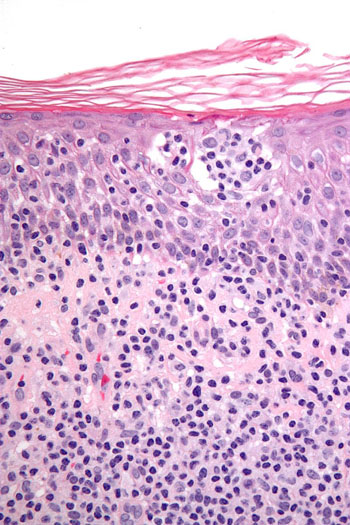Bacterial Toxins Promote Growth of Rare Skin Cancer
By LabMedica International staff writers
Posted on 19 Jan 2016
Toxins secreted by some types of skin bacteria have been shown to promote the growth of the rare skin cancer, cutaneous T-cell lymphoma (CTCL).Posted on 19 Jan 2016
CTCL is a class of the immune system cancer non-Hodgkin lymphoma. Unlike most non-Hodgkin lymphomas (which are generally B-cell related), CTCL is caused by a mutation of T-cells. The malignant T-cells in the body initially migrate to the skin, causing various lesions to appear. These lesions change shape as the disease progresses, typically beginning as what appears to be a rash, which can be very itchy, and eventually forming plaques and tumors before metastasizing to other parts of the body. With disease progression, bacteria colonize the compromised skin barrier, and half of CTCL patients die from infection rather than from direct organ involvement by the malignancy. CTCL is a rare form of cancer with only about 50 people in Denmark being diagnosed with the disease annually.

Image: Very high magnification micrograph of cutaneous T-cell lymphoma (Photo courtesy of Wikimedia Commons).
While clinical data indicate that bacteria play a direct role in disease progression, little is known about the mechanisms involved. In a study that was published in the January 6, 2015, online edition of the journal Blood, investigators at the University of Copenhagen (Denmark) defined the role of bacteria in the progression of CTCL.
The investigators demonstrated that bacterial isolates containing staphylococcal enterotoxin-A (SEA) from the affected skin of CTCL patients, as well as recombinant SEA, stimulated activation of STAT3 (signal transducer and activator of transcription 3) and up-regulation of IL-17 (Interleukin-17).
STAT3 is a member of the STAT protein family, which regulates many aspects of cell growth, survival, and differentiation. Malfunction of this signaling pathway is frequently observed in primary tumors and leads to increased angiogenesis and enhanced tumor survival. IL-17 is an immune system protein involved in the signaling cascade that prompts skin cells to multiply in excess numbers.
As SEA induced STAT3 activation and IL-17 expression in malignant T-cells when co-cultured with non-malignant T-cells, it was apparent that SEA induced a type of cell cross-talk as part of a mechanism where SEA-producing bacteria promoted activation of an established oncogenic pathway previously implicated in carcinogenesis.
"We have gained important insight into the processes that activate cancer cells and make them grow. Patients' frequent bacteria infections might not be a mere side effect of the disease—on the contrary, toxins in the bacteria actually "benefit" cancer cells. Our next step is examining whether combating infections can slow down the growth of cancer cells and thus stop the disease," said senior author Dr. Niels Odum, professor of immunology and microbiology at the University of Copenhagen.
Related Links:
University of Copenhagen













